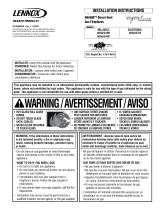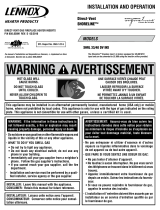
2
LENNOX HEARTH PRODUCTS • MONTEBELLO® SEE-THROUGH DIRECT-VENT GAS FIREPLACES (LSM40ST-N / LSM40ST-P) • INSTALLATION INSTRUCTIONS
TABLE OF CONTENTS
Packaging ................................................... 2
Introduction ................................................ 2
Approved Vent Components .................... 2
General Information .................................... 2
Misc. Codes/Standards ........................... 3
Inputs and Efficiencies ............................ 3
Gas Supply Pressure Requirements ........ 3
Gas Valve Diagram ................................. 4
Orifice Sizes ............................................ 4
Massachusetts / NYC Requirements ....... 4
Cold Climate Insulation ............................... 5
Manufactured Home Requirements ............ 5
Location ...................................................... 5
Vent Termination Clearances ...................... 6
Hearth Extensions (Optional) ...................... 8
Minimum Clearances to Combustibles ........ 9
Pre-Installation Steps .................................. 10
Typical Installation Sequence ..................... 10
Detailed Installation Steps:
Step 1. Framing .......................................... 10
Framing Specifications ............................. 11
Fireplace Dimensions ............................... 12
Step 2. Route Gas Line .............................. 13
Step 3. Install Vent System ........................ 14
General Information ................................. 14
Vent Restrictor Assembly/Installation ...... 14
Vent Termination (Vertical/Horizontal) ..... 14
Vertical (Roof) Termination ...................... 15
Vertical Termination with Straight
Vertical Venting ............................... 15
Straight Vent Section Lengths Table ... 15
Vertical Termination with Offset
Vertical Venting ............................... 16
Vertical Termination System Figures
and Tables ........................................ 18
Horizontal (Wall) Termination .................. 19
Horizontal Termination System
Figures and Tables ........................... 21
Step 4. Field Wiring .................................... 23
Step 5. Remove Glass Door ....................... 23
Step 6. Connecting Gas Line ...................... 24
Step 7. Install Firebox Liner Panels ............ 25
Step 8. Verify Appliance Operation ............. 25
Step 9. Install Volcanic Stone, Glowing
Embers, and Logs .................................... 26
Step 10. Install Glass Doors, Mesh Pull
Screens, and Modesty Panel ................... 29
Step 11. Burner Adjustments ..................... 30
Finishing Requirements .............................. 31
Step 12. Attaching Safety-in-Operation
Warnings ..................................... 33
Installation Accessories .............................. 34
Gas Conversion Kits .......................... 35
WARNING
Young children should be care-
fully supervised when they are
in the same room as the appli-
ance. Toddlers, young children
and others may be susceptible
to accidental contact burns. A
physical barrier is recommended
if there are at risk individuals in
the house. To restrict access to
a fireplace or stove, install an
adjustable safety gate to keep
toddlers, young children and
other at risk individuals out of
the room and away from hot
surfaces.
AVERTISSEMENT
Les jeunes enfants devraient être
surveillés étroitement lorsqu’ils
se trouvent dans la même pièce
que l’appareil. Les tout petits,
les jeunes enfants ou les adultes
peuvent subir des brûlures s’ils
viennent en contact avec la sur-
face chaude. Il est recommandé
d’installer une barrière physique
si des personnes à risques habi-
tent la maison. Pour empêcher
l’accès à un foyer ou à un poêle,
installez une barrière de sécu-
rité; cette mesure empêchera les
tout petits, les jeunes enfants et
toute autre personne à risque
d’avoir accès à la pièce et aux
surfaces chaudes.
Children and adults should be alerted to the
hazards of high surface temperature and
should stay away to avoid burns or clothing
ignition.
Les enfants et les adultes devraient être
infor-més des dangers que posent les
températures de surface élevées et se
tenir à distance afin d’éviter des brûlures
ou que leurs vêtements ne s’enflamment.
DO NOT ATTEMPT TO ALTER OR MODIFY
THE CONSTRUCTION OF THE APPLIANCE OR
ITS COMPONENTS. ANY MODIFICATION OR
ALTERATION MAY VOID THE WARRANTY,
CERTIFICATION AND LISTINGS OF THIS UNIT.
GENERAL INFORMATIONPACKAGING
The assembled vented gas replace is pack-
aged with the following items:
• Fireplace Components:
(1) Literature Kit (in envelope in rebox;
contains Care and Operation Instruc-
tions, Installation Instructions, safety-
in-operation warning labels, warranty)
(1) Remote Control Kit (in plastic bag in re-
box; contains remote control, receiver)
(1) Log Set
(1) Vent Restrictor Assembly
(1) bag Glowing Embers
(4) bags Volcanic Stone
(1) Door Modesty Shield
• Panel Kit (sold separately; REQUIRED for all
replace models) - one of the following kits:
– Architectural Stone Ceramic
– Venetian Tile Ceramic
– Buff Herringbone Ceramic
– Buff Rustic Ceramic
– Black Rustic Ceramic
– Black Porcelain
• Outdoor Installation Kit (sold separately;
REQUIRED for indoor/outdoor installations)
INTRODUCTION
The Montebello™ See-Through is a direct-vent,
sealed combustion gas replace designed
for either indoor/indoor or indoor/outdoor
residential applications (including screened
porches and lanais). See “Minimum Clearances
to Combustibles” on Page 9.
NOTE: INDOOR/OUTDOOR INSTALLATIONS
REQUIRE AN OUTDOOR INSTALLATION KIT
(SOLD SEPARATELY).
These appliances are designed to operate on
natural or propane gas. The system is switch-
able between standing and intermittent pilot
modes.
External electrical power is required to oper-
ate these units. If the system operates on line
voltage, four “AA” batteries (in receiver) can
be used as a backup in case of a power outage.
Approved Vent Components
These fireplaces are designed, tested, and listed
for operation and installation with the following
vent components (8" inner and 11" outer) only:
• SecureVent™ SV8 direct-vent system com-
ponents manufactured by Security Chimneys
International.
These approved vent system components are
labeled for identication. Do NOT use any other
manufacturer’s vent components with these
appliances.




























